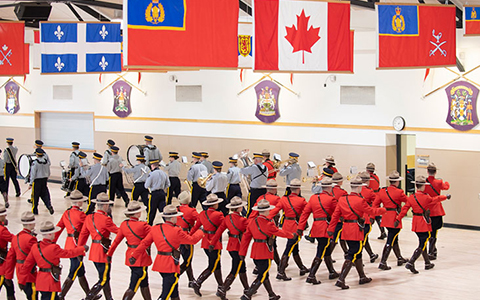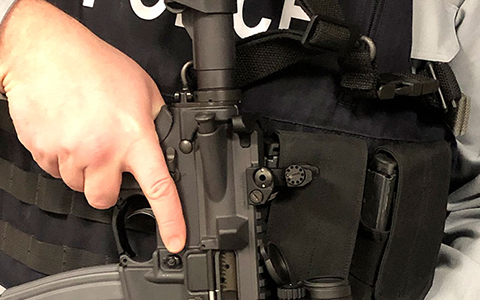Week 7: Expect the unexpected
Judgment simulators and firearms training
This week, cadets have an introduction to the Judgment Simulator System. This training tool creates true-to-life simulations to practice judgement and skills.
Cadets also have their first pistol test. This allows them to see how far their skills have come since they first started shooting.
First Sergeant Major's Parade

By week 7, cadets display their abilities and teamwork as they earn the right to take part in the Sergeant Major's Parade. This daily parade includes a roll call and inspection of the troops.
The Sergeant Major's Parade is a local tourist attraction here in Regina. Many visitors from across Canada and beyond come to watch.
My first Sergeant Major's parade was as a band member. I love marching with the band and hearing the marching songs and bass drum keeping everyone in step.
Being able to coordinate many different troops and members will be very useful in the field as police operations require a lot of different police officers, specialized units, and partners that need to be able to work together to achieve the end goal.
Introduction to conducted energy weapons
A conducted energy weapon (CEW) is commonly referred to as a Taser. Cadets learn about the safe use of CEWs, their limitations and the risks linked with their use.
Officer-violator contact
Expecting the unexpected is an important lesson cadets learn throughout training. Police work is dangerous. When an officer comes into contact with a subject for the first time, it can be risky.
During basic training, cadets build their toolkits and skills for the field. They learn how to complete background checks and important officer safety techniques.
The training environment creates a safe place where they can learn and make mistakes. All this practice helps them in the field where stakes are much higher.
Introduction to carbine

The patrol carbine is a compact rifle now used by many police agencies to address specific threats. It provides a use-of-force option that increases officer and community safety. Carbine training is now integrated into the Cadet Training Program.
Before ever using a carbine, cadets learn safe handling and ammunition management techniques. Cadets spend a significant amount of time familiarizing themselves with it. They learn how to load and unload the weapon, how to position their body and how to handle the safety mechanism.
Once cadets become proficient with the carbine, they will shoot it on the live-fire range.
I was surprised by the difference of the trigger pull and how easy it is to use, despite how heavy the carbine is.
Highlights
Kit issue #2: Blues and breechess
In the second kit issue, cadets receive their "blues". These are the RCMP's standard-issue blue pants with a bright yellow stripe down the side.
Before they can wear these new pants, the troop must pass the "blues challenge". Cadets answer a series of questions to test their attention to detail. Until they pass the challenge as a troop, they continue to wear their fatigues.
At the same time, cadets receive their breeches. You know, the "puffy" pants worn with the red serge!
Did you know?
The yellow stripe on RCMP pants denotes they are cavalry, as the Force was a mounted regiment.
Depot spotlight: Leathercraft
The leathercraft unit outfits each cadet with pieces of the ceremonial kit. This includes the high brown boots, leather hatband and Sam Browne belt.
Leathercraft staff stretch and cut each pair of boots to fit each individual. This is a meticulous process that the Leathercraft unit takes great pride in. Once customized for them, it is up to cadets to shine their boots and belts. It takes at least 20 coats of polish to do so.
To have and to care for the ceremonial uniform is a very special experience for cadets.
Little sibling troop
It is around this time in training that the troop becomes a "big sibling" to the newest arrivals. They act as mentors to the incoming cadets and play an important role in welcoming them to Depot.
- Date modified: